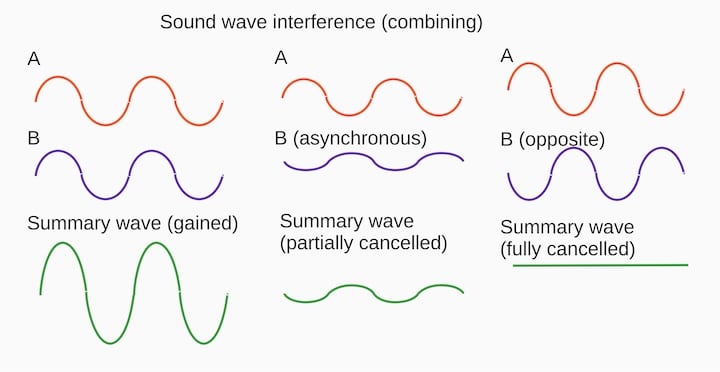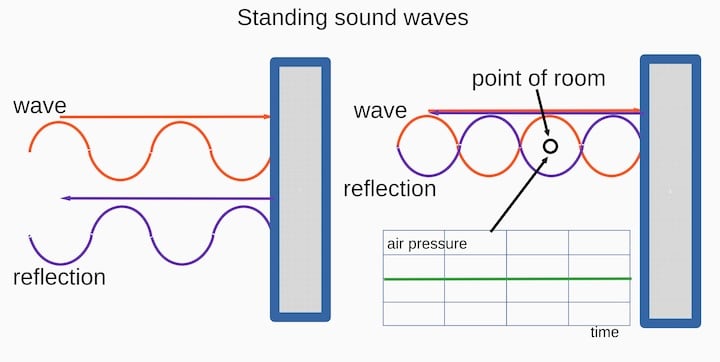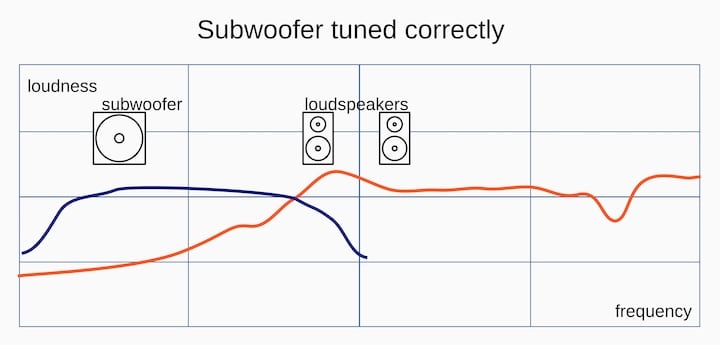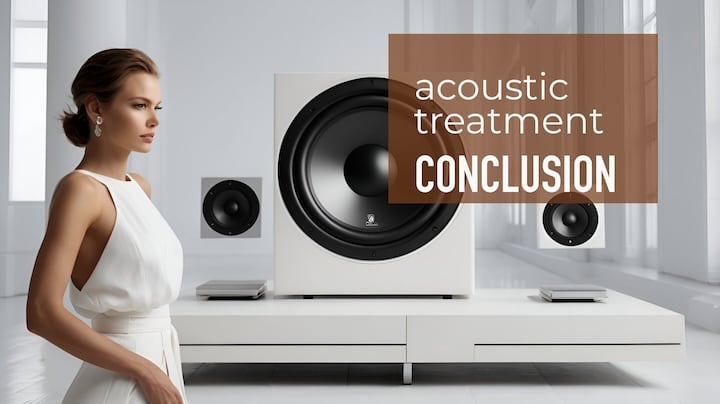![Acoustic Treatment [How to Improve Audio Quality]](jpg/acoustic-treatment-720.jpg)
In our pursuit of perfect sound, we often neglect an essential element: the space where we listen. You've spared no expense on high-quality audio gear, yet the result is less than stellar. The sound is unclear, the bass overpowers, and the sought-after clarity is lost amidst the room's reverberations. The issue lies not with your equipment but with the acoustics of the room. Unwanted echoes, stationary waves, and acoustic anomalies are undermining your audio experience.
However, there's no need to worry. Today marks the beginning of an auditory adventure to refine your environment and elevate your listening experience to its potential. Keep reading.

WARNING: To safeguard your hearing and equipment, refrain from excessive volume. Begin quietly and gradually raise the volume to a safe level. Overly loud signals can introduce distortions, compromising measurement precision. Ultrasound might be imperceptible yet still pose a risk to your hearing.
Disclaimer: The efficiency of the sound quality improvement described in the guideline depends on the listening room, equimment, software used, your skills, available treatment items and their application. An improvement in sound quality is not guaranteed.
Back to top
Objectives of Acoustic Treatment

The objectives of acoustic treatment differ with each space. In a home theater or listening room, the aim is to create a captivating sound that draws you into the narrative, making every film or concert an immersive experience.
In a recording studio, accuracy is crucial, as the intent is to capture every detail of the performance, reflecting the true sound of the source. In a studio setting, it's possible to replicate the listener's environment, where absolute precision may not be the primary concern.
Whether it's the excitement of a movie or the fidelity of a studio recording, acoustic treatment enhances the audio experience, bringing it closer to perfection.

If you buy "AuI ConverteR PROduce-RD" (2023/12.x version) from 24 August 2023 to 24 October 2023, you will get free update to version 2024 (13.x) after its release.
Back to top
A bit of the science of acoustics

Let's delve into the science of acoustics to grasp the efficacy of acoustic treatment.
Acoustics, a fascinating branch of physics, is concerned with the study of sound as it travels in waves, much like the ripples that spread across a body of water. These waves carry melodies and harmonies through the air to our ears, interacting with everything they encounter. Soft materials can absorb these waves, while hard surfaces reflect and scatter them in various directions.


When sound waves of identical frequency meet, they can either negate or intensify one another. If they oscillate in unison, they bolster each other's presence. If their oscillations are out of sync, they can diminish each other, and if they are in direct opposition, they can nullify each other entirely.

Sound waves are also capable of bending around objects, particularly when the object's size is similar to the wavelength of the sound.
Standing waves
A phenomenon known as a standing wave can occur when an acoustic wave and its reflection interact, causing cancellations at specific points in a room. This effect is localized to particular listening spots and frequencies, making it possible that we won't hear a frequency clearly, even if it's being played loudly by our speakers. This is why simply increasing the gain on an equalizer may not improve audibility at these points. However, it's worth noting that the frequency might be audible at other locations within the room.

To ensure a frequency is heard at a desired spot, we might need to adjust the speaker's position or orientation, or modify the reflections from walls, ceilings, and floors. This adjustment is crucial for managing the standing acoustic waves at the listening point. Understanding these interactions is key to shaping a room's acoustics, blending science with the art of sound.
In essence, considering the science of sound involves acknowledging the acoustic wavelengths in our surroundings. Being aware of these allows for effective manipulation of sizes and positions in acoustic room treatment. For instance, an acoustic wave can have wavelengths as long as 17 meters at 20 Hz, while at 20,000 Hz, the wavelength shrinks to just 1.7 centimeters.
Back to top
Measurements

The first step in customizing your acoustic setting is to take precise measurements. These metrics will illuminate the acoustic personality of your space, highlighting the highs and lows of sound throughout the frequency range. This information allows us to pinpoint problematic frequencies and spots where sound acts incorrectly. With this insight, we edge closer to perfecting your auditory environment.
Typically, you might not possess specialized tools to gauge your room's frequency response accurately. Nevertheless, a computer equipped with sound-generating software or a smartphone app that visualizes the audible frequency spectrum can suffice.

Employ a sine wave signal spanning from 20 Hz to 20,000 Hz. Should you be unable to discern frequencies beyond a certain point, as rule, there's no need to measure beyond that threshold.
You'll detect resonances at certain frequencies—these will sound disproportionately loud. You might also notice unusual vibrations in room elements. Conversely, some frequencies may sound quieter than average. Document any frequencies that are noticeably louder or softer.
Back to top
Acoustic treatment

Acoustic treatment isn't governed by strict rules; it's open to experimentation with reverberation and absorption.
Let's confront the primary issue: resonant frequencies. These culprits amplify specific frequencies, often resulting in a boomy or muffled audio quality. Our objective is to quell these resonances, mainly through the calculated arrangement of acoustic treatments and potentially adjusting speaker positions.
What about the subdued frequencies? These are typically the byproducts of your room's distinctive traits. Take into account the dimensions, layout, and materials present in your room.
Textiles like carpets can soak up sound.
Hard surfaces such as ceramic, glass, and particularly large windows, tend to reflect it, complicating the pattern of sound waves and thus muffling certain frequencies.
It's ill-advised to boost these subdued frequencies without grasping their origin. At times, the remedy is as straightforward as reorganizing your furnishings.
Start by clearing the room of movable furniture and decorations. Remove and rehang curtains, lift and replace carpets, and repeat with other objects. Rearranging these items might just be the key to your acoustic success.
Back to top
Methods of Acoustic Treatment

Before starting acoustic treatment, ensure the equalizer is set to bypass, or all band sliders are at neutral.
There are various methods to achieve acoustic excellence. Foam panels, for instance, can be placed on walls and ceilings to dampen excess sound.
Bass traps are vital in corners where sound waves tend to bounce back. Installing a panel at a 45-degree angle in a corner can minimize reflections and reduce standing waves, especially if the trap includes an air gap.

Diffusers are designed to disperse sound waves, diminishing focal points and fostering a more organic soundscape. They also help manage reflections that contribute to standing waves, thereby reducing frequency-specific attenuations and resonances.
Remove any items that resonate at certain frequencies from the room, or secure them to prevent mechanical impact from acoustic waves. For example, wine glasses or plates might be relocated, or you could attempt to shield cupboard contents from external sound waves.
Back to top
Tune subwoofer

Avoid placing objects in the path of subwoofer emissions, as this can lead to unwanted vibrations and sound distortion.
When adjusting a subwoofer without measurement tools, experiment with the cutoff frequency and gain. Start with the gain at its lowest setting, using a sound generator with sweep sines, simple tones, or bass-heavy music samples for tuning.

Increase the level gradually to balance it with the rest of the frequency range, being mindful of the volume to protect your hearing.

Adjusting the cutoff frequency is crucial to avoid gaps or resonances in the low-frequency spectrum. After setting the cutoff, you can fine-tune the subwoofer's gain.



If the results aren't satisfactory, take a break and try again later, as this process benefits from experience.
Some subwoofers offer loudness compression to prevent excessively loud sounds during movies. Choose a setting that suits your preference.
An equalizer can help mitigate resonant frequencies, which may be caused by standing waves at certain points in the room. Before resorting to an equalizer, consider addressing the issue with acoustic panels and bass traps.
Back to top
Conclusion

As we conclude this guide, your personal quest for acoustic excellence is just beginning. With the insights you've acquired and the adjustments you've implemented, every note and rhythm now reflects your commitment to sound quality. Your space is finely tuned, offering not just improved audio, but also a harmonious atmosphere for your ears and spirit.
Acoustic treatment can be stylish as well as functional. Modern solutions can enhance both the sound and appearance of your room.
Thank you for embarking on this sonic exploration. May your environment resonate with the sound of perfection.
Audio Basis - articles about audio
Back to top